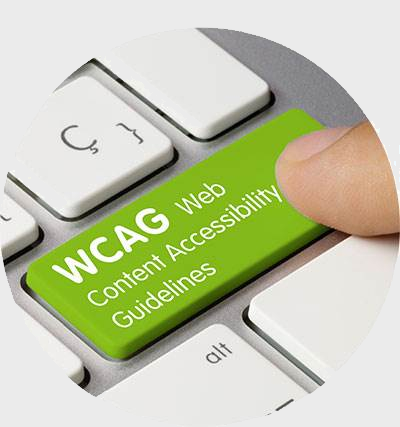
Web accessibility might be one of those compliance-type topics that you've heard about but have been hesitant to tackle. But taking a proactive approach to web accessibility will be vital to your company in 2022, and I'll highlight exactly why now's the time for you to address it and show you an easy way to get it done. (Get a free accessibility report!)
But first of all, what is web accessibility?

Web accessibility is about making sure that your website content can be used and accessed by everyone, regardless of their abilities. It's another aspect of user experience (UX) design, making your website inclusive to everyone.
How do you do this? Web developers structure your business website so it can be read by screen readers and electronic Braille devices, using small, technical changes. A great example of website accessibility is adding alternative or “alt” text on all images so that screen readers can read the description of the image for visually-impaired users. Without alt text so users can enjoy the visible elements, these users may not have a rewarding experience and may not convert into customers.
Why should website accessibility matter to my business?
While web accessibility has often been overlooked as a nice-to-have, rather than a need-to-have — that’s changing, and here’s why.
It affects more people & processes than you think
 In the digital world that we live in today, websites are vital to providing information and in some instances even daily operations. Websites drive key processes for industries including private organizations, government services, to e-commerce, healthcare and more.
In the digital world that we live in today, websites are vital to providing information and in some instances even daily operations. Websites drive key processes for industries including private organizations, government services, to e-commerce, healthcare and more.
In fact in one of Monsido's recent webinars on “Web A11y 101”, we mentioned that companies lose around $6.9 billion a year in revenue due to people with disabilities not being able to access their site. And given that, 1 in 4 people in just the United States alone live with a disability - (you may already be putting together the business case in your mind!) prioritizing web accessibility cannot only help improve the user experience on your website, but it can also drive more conversions.
Beyond the business reasons, web accessibility is also a matter of legal compliance (which I discuss further down in this blog post). It's also ultimately the right thing to do for a more inclusive experience for your website visitors.


Companies lose around $6.9 billion a year in revenue because people with disabilities cannot access their business website.

There's an increased digital reliance in our society
During the COVID-19 pandemic, there’s also been a sharp rise in the use of digital services. More of us -- including the older generations -- are relying on doing everything digitally. This is something that is likely to continue in the future. In a recent Forbes article, a key point was that “Many of this population segment does not self-identify as being disabled but might instead, live with milder age-related impairments such as reduced visual acuity or cognition.” This is a key example of how web accessibility goes beyond assisting people with disabilities but actually plays into the overall general user experience.
Lawsuits related to web accessibility are rising
 Website accessibility lawsuits have been on the rise in 2021, with the sharpest increase in New York and California. And while the threat of a lawsuit shouldn't be the reason why you address web accessibility, it is a very real outcome. And while the majority of lawsuits are primarily filed by six law firms targeting specific industries (primarily e-commerce and retail, but also beauty, food & beverage, and healthcare), there has been a 14% year-on-year increase in the number of web accessibility complaints filed. And while it's attractive to work towards ADA accessibility compliance in order to avoid litigation, it is also the right thing to do to promote a more inclusive online experience for your website visitors.
Website accessibility lawsuits have been on the rise in 2021, with the sharpest increase in New York and California. And while the threat of a lawsuit shouldn't be the reason why you address web accessibility, it is a very real outcome. And while the majority of lawsuits are primarily filed by six law firms targeting specific industries (primarily e-commerce and retail, but also beauty, food & beverage, and healthcare), there has been a 14% year-on-year increase in the number of web accessibility complaints filed. And while it's attractive to work towards ADA accessibility compliance in order to avoid litigation, it is also the right thing to do to promote a more inclusive online experience for your website visitors.
New web compliance standards are rolling in

Web accessibility standards are still evolving. As of this writing, the Americans with Disabilities Act (ADA) currently mandates compliance with Web Content Accessibility Guidelines (WCAG) 2.0, despite the latest version being 2.1. But don't get too comfortable: WCAG 2.2 is expected to be released in 2022, and the ADA may require WCAG 2.1 or 2.2 compliance overnight. Disability advocate Sheri Byrne-Haber predicts that WCAG 2.2 will be the new standard for private companies in 2022. Think you can wait? Well, WCAG 3.0 has also been announced, with the expectation of finalization in 2023 or early 2024.
If you're wondering where your website stands for ADA compliance, we've got great news. With our partner, LRS Web Solutions, we're offering a free scan of your website so you can know your accessibility status and make sure your business website meets WCAG 2.0.
Now is the time to check your website accessibility
So to conclude, web accessibility isn’t any longer something to be overlooked. It’s not only impacting the way visitors interact with our businesses, but also the overall user experience they have when engaging with us (regardless of whether they consider themselves disabled or not). Beyond that, a lack of web accessibility is now beginning to have real consequences for business and organizations, and it doesn’t look to be slowing down any time soon. Rather, web accessibility is something that is here to stay, and needs to be incorporated for a successful digital experience in the future.
Want to see how accessible your site is? Get a free scan of your website to see how your website performs on web accessibility, broken links, misspellings, performance, and more.
